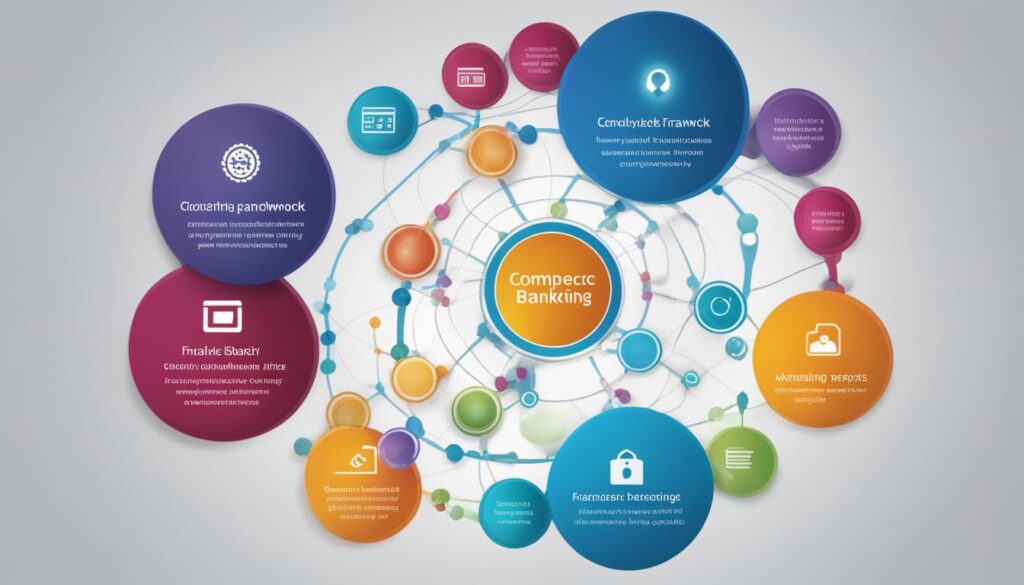Mobile banking has revolutionized the way people manage their finances, offering convenience and accessibility at our fingertips. However, with this convenience comes the need for robust compliance and adherence to regulations in order to protect sensitive financial data and ensure the security of transactions.
Financial guidelines and banking policies play a critical role in maintaining the integrity of mobile banking systems. Compliance with mobile banking regulations is not only a legal requirement but also a means to mitigate cybersecurity and privacy threats that are prevalent in today’s digital landscape.
In this article, we will delve into the complexities of mobile banking compliance and regulations, exploring the various guidelines and laws that govern the industry. We will discuss the importance of incorporating security measures into the design of mobile banking systems, the development of risk frameworks, and the significance of adhering to industry standards.
Key Takeaways:
- Compliance with mobile banking regulations is essential to protect customer data and secure financial operations.
- Mobile banking companies must embed security measures into their initial design and develop risk frameworks to ensure compliance with global data protection regulations.
- Adhering to industry standards, such as the Payment Card Industry Data Security Standard (PCI DSS) and General Data Protection Regulations (GDPR), is crucial for maintaining compliance.
- Non-compliance with mobile banking regulations can lead to severe penalties, reputational damage, and financial consequences.
- Staying proactive and up-to-date with the evolving regulatory landscape is key for successfully navigating mobile banking compliance and regulations.
Privacy by Design: Integrating Privacy into Mobile Banking Systems
Privacy by Design is a fundamental practice in modern IT and cybersecurity, emphasizing the inclusion of privacy features and considerations from the initial stages of system design. This approach is especially pertinent in the context of mobile banking systems, where protecting user data and privacy is of paramount importance.
Integrating Privacy by Design into mobile banking systems helps address data privacy threats and ensures compliance with applicable privacy regulations. By incorporating privacy principles and safeguards into every aspect of system development, FinTech companies can enhance customer trust and minimize the risk of data breaches or unauthorized access.
Compliance management plays a crucial role in achieving Privacy by Design. Companies must stay abreast of privacy regulations relevant to the mobile banking industry and implement necessary controls and safeguards accordingly. By taking a proactive approach to privacy compliance, FinTech companies can establish a robust culture of privacy and safeguard the sensitive information entrusted to them by their customers.
Benefits of Privacy by Design in Mobile Banking Systems
- Enhanced security: Privacy by Design fosters a security-focused culture, ensuring that robust security measures are implemented to protect user data from unauthorized access.
- Enhanced customer trust: By prioritizing privacy and data protection, FinTech companies can build stronger relationships with their customers and foster trust, ultimately improving customer loyalty and retention.
- Compliance with privacy regulations: Integrating privacy into mobile banking systems helps ensure compliance with applicable privacy regulations, reducing the risk of penalties and reputational damage resulting from non-compliance.
- Minimized data breach risk: Privacy by Design helps identify and address potential vulnerabilities in mobile banking systems, reducing the risk of data breaches and associated financial and legal consequences.
Implementing Privacy by Design in mobile banking systems is not only crucial for protecting customer data but also for ensuring regulatory compliance and fostering customer trust. By incorporating privacy principles from the outset, companies can enhance security, reduce the risk of data breaches, and build stronger, long-lasting relationships with their customers.
| Privacy Regulations | Key Requirements |
|---|---|
| General Data Protection Regulations (GDPR) | Obtain user consent for data collection and processing, implement appropriate security measures, provide transparency in data handling. |
| Payment Card Industry Data Security Standard (PCI DSS) | Protect cardholder data, implement strong access controls, regularly monitor and test systems for vulnerabilities. |
| Revised Payment Services Directive (PSD2) | Ensure strong customer authentication, protect against fraudulent activities, provide open banking access to authorized third parties. |
| Gramm-Leach-Bliley Act (GLBA) | Maintain privacy notices, safeguard customer information, protect against unauthorized access or use of customer data. |
Mitigating Risks: Developing a Risk Framework for Mobile Banking Compliance
Risk management plays a vital role in ensuring compliance with regulations in the mobile banking industry. To effectively manage and mitigate risks, FinTech companies must develop a comprehensive risk framework that addresses both regulatory and operational risks. This framework serves as a guide for identifying, assessing, and managing risks, allowing businesses to navigate the complex landscape of compliance management with confidence.
Creating a risk framework involves several key steps. First, it is crucial to identify and prioritize the potential risks that the company may face. This includes regulatory risks specific to the mobile banking industry, such as non-compliance with privacy regulations or data breaches. Additionally, operational risks, such as system failures or employee errors, should also be considered.
Once the risks are identified, they need to be assessed in terms of their potential impact and likelihood of occurrence. This helps in determining the level of risk that each identified threat poses to the company. With this information, appropriate risk mitigation measures can be developed and implemented. Regular testing and monitoring of these measures is essential to ensure their effectiveness and adapt them to evolving threats.
Developing a Culture of Risk Management
Effective risk management goes beyond implementing processes and procedures. It requires developing a culture that values risk awareness and encourages employees to voice concerns related to risk. By empowering employees to be proactive in identifying and reporting risks, companies can create a collaborative environment that fosters risk management.
Training programs and awareness campaigns can also help in ingraining risk management into the company’s ethos. By educating employees about the importance of compliance and the potential consequences of non-compliance, companies can ensure that every individual understands their role in managing and mitigating risks.
| Risk Category | Example | Impact | Likelihood | Risk Level |
|---|---|---|---|---|
| Regulatory Risk | Non-compliance with GDPR | High | Medium | Medium |
| Operational Risk | System failure | High | Low | Medium |
| Security Risk | Data breach | High | High | High |
By developing a robust risk management framework and fostering a culture of risk awareness, FinTech companies can proactively address regulatory risks, operational risks, and security risks. This not only ensures compliance with mobile banking regulations but also establishes a strong foundation for trust and reliability in the industry.

Following the FinTech Regulatory Landscape: Compliance with Industry Standards
In the fast-paced world of mobile banking, staying compliant with industry standards and regulations is of utmost importance for FinTech companies. With the ever-evolving FinTech regulatory landscape, it is crucial for these companies to be well-informed and adhere to the necessary compliance standards to ensure the security and integrity of their operations.
Various FinTech regulations and financial laws govern the industry, and compliance with them is key to avoid legal and financial consequences. Some of the major standards that FinTech companies need to follow include the Payment Card Industry Data Security Standard (PCI DSS), ISO/IEC 27001, General Data Protection Regulations (GDPR), Revised Payment Services Directive (PSD2), and the Gramm-Leach-Bliley Act (GLBA).
Complying with these regulations and standards is not only a legal requirement but also essential for building trust with customers and creating a secure environment for financial transactions. By implementing robust security measures and adhering to industry best practices, FinTech companies can mitigate risks and protect sensitive customer data.
Benefits of Compliance with Industry Standards
Compliance with industry standards brings several benefits to FinTech companies, including:
- Enhanced security: Adhering to industry standards helps strengthen the security infrastructure of FinTech companies, reducing the risk of data breaches and cyber-attacks.
- Improved customer trust: Demonstrating compliance with industry standards reassures customers that their financial information is protected and instills confidence in the company’s services.
- Competitive advantage: Compliance with industry standards sets FinTech companies apart from their non-compliant competitors, enhancing their reputation and attracting more customers.
- Streamlined operations: Following established standards and regulations allows FinTech companies to streamline their internal processes and ensure efficient operations.
In conclusion, FinTech companies must stay informed about the latest regulations and compliance standards to successfully navigate the complex regulatory landscape. By prioritizing compliance and following industry best practices, these companies can safeguard their operations, protect customer data, and maintain a competitive edge in the mobile banking industry.

The Consequences of Non-Compliance: Penalties for Violating Mobile Banking Regulations
Non-compliance with mobile banking regulations can have serious repercussions for financial institutions. Failure to adhere to regulatory requirements, such as those outlined in the Gramm-Leach-Bliley Act (GLBA), can result in hefty financial penalties and reputational damage. Additionally, data breaches caused by inadequate security measures can lead to significant legal consequences.
Under the GLBA, financial institutions that do not meet the Act’s privacy and security requirements may face civil penalties of up to $11,000 per violation. These penalties can quickly add up, posing a substantial financial burden on non-compliant organizations. Furthermore, repeated violations or egregious non-compliance can result in criminal penalties, including fines and imprisonment.
“Compliance with mobile banking regulations is not only a legal requirement but also essential for maintaining customer trust and confidence. Non-compliance can erode consumer trust and loyalty, which can have far-reaching consequences for a financial institution’s bottom line.”
Aside from financial penalties, non-compliance can also cause significant reputational damage. In today’s digital age, news of data breaches and non-compliance with privacy regulations spreads rapidly, potentially tarnishing a company’s brand and image. The loss of consumer trust can lead to a decline in customer acquisition and retention, ultimately affecting the financial success of the institution.
| Consequences of Non-Compliance | Penalties | Reputational Damage | Data Breach |
|---|---|---|---|
| Financial Penalties | GLBA imposes civil penalties of up to $11,000 per violation | Loss of consumer trust and loyalty | Potential legal consequences |
| Reputational Damage | Damage to brand and image | Impact on customer acquisition and retention |
Financial institutions must prioritize compliance with mobile banking regulations to avoid these penalties and safeguard their operations. Establishing robust security measures, implementing stringent privacy controls, and regularly auditing and updating compliance strategies are key steps towards mitigating non-compliance risks. By adhering to the GLBA and other relevant regulations, financial institutions can protect themselves, their customers, and their reputation.
Conclusion
In conclusion, compliance with mobile banking regulations is of utmost importance in today’s digital era. It is essential for FinTech companies to navigate the complex landscape of mobile banking compliance and regulations to safeguard financial operations and protect customer data.
Staying up-to-date with the latest standards and regulations, including the Gramm-Leach-Bliley Act (GLBA), is crucial for maintaining compliance. Implementing privacy by design, developing risk frameworks, and following industry standards are key steps in ensuring adherence to mobile banking regulations.
Non-compliance can have significant consequences, both financially and reputationally. The GLBA imposes civil and criminal penalties for violations, and financial institutions may face fines and imprisonment for non-compliance. Additionally, reputational damage and loss of consumer trust are potential outcomes of inadequate compliance.
By prioritizing compliance and proactively addressing regulatory requirements, FinTech companies can effectively navigate the challenges posed by mobile banking compliance and regulations, ensuring the security and trust of their customers.
FAQ
What are some key practices in mobile banking compliance?
Key practices in mobile banking compliance include embedding privacy by design, developing risk frameworks, and following industry standards and regulations.
Why is privacy by design important in mobile banking systems?
Privacy by design is important in mobile banking systems to promote a robust culture of privacy and ensure compliance with privacy regulations and requirements.
What is the significance of risk frameworks in mobile banking compliance?
Risk frameworks are significant in mobile banking compliance as they help identify and manage regulatory and operational risks, enabling effective risk-based actions.
Which industry standards and regulations should FinTech companies comply with?
FinTech companies should comply with various regulations and standards, including the Payment Card Industry Data Security Standard (PCI DSS), ISO/IEC 27001, General Data Protection Regulations (GDPR), Revised Payment Services Directive (PSD2), and the Gramm-Leach-Bliley Act (GLBA).
What are the consequences of non-compliance with mobile banking regulations?
Non-compliance with mobile banking regulations can result in severe penalties, including fines and imprisonment. It can also lead to reputational damage and financial/legal consequences due to data breaches and inadequate security measures.
How Can Antivirus Software Help Protect Against Compliance and Regulation Risks in Mobile Banking?
Antivirus software plays a crucial role in mobile banking by safeguarding against compliance and regulation risks. With an increase in cyber threats, such software ensures the protection of sensitive data, preventing unauthorized access or breaches. By scanning for malware and viruses, it acts as a shield, keeping customers’ financial information secure and upholding compliance standards. The role of antivirus in mobile banking is paramount for a safe and trustworthy banking experience.


Pingback: Stay Alert: How to Set Up and Use Mobile Banking Alerts Wisely – Straight Fire Money